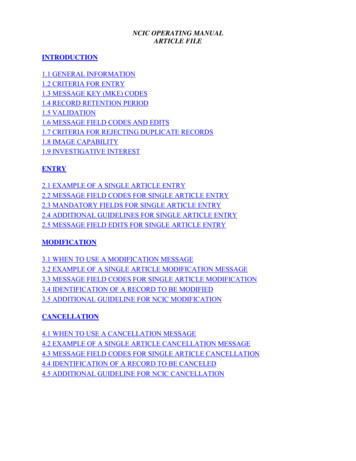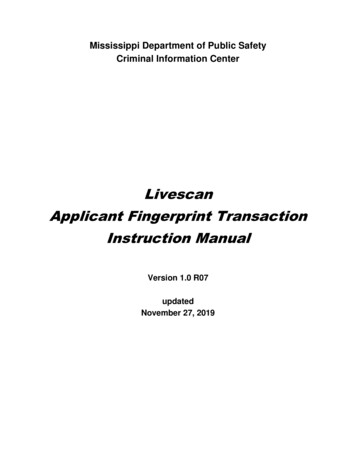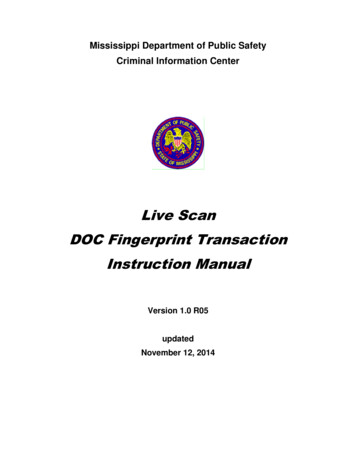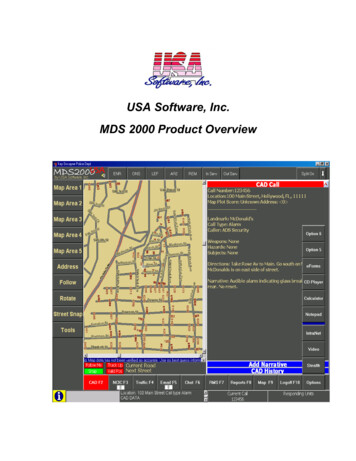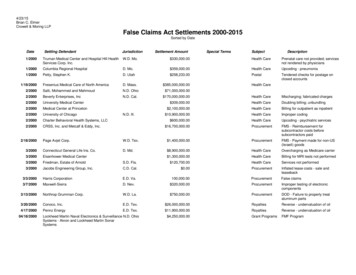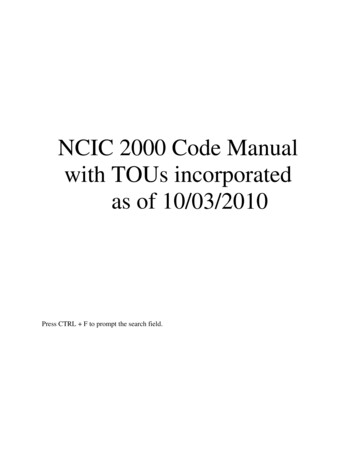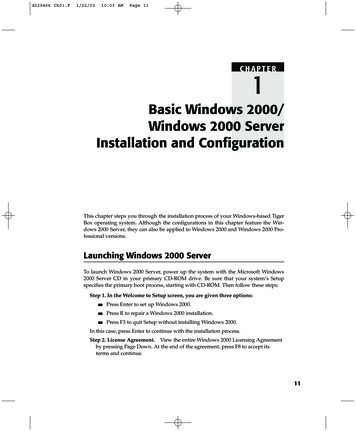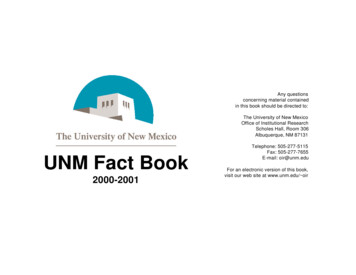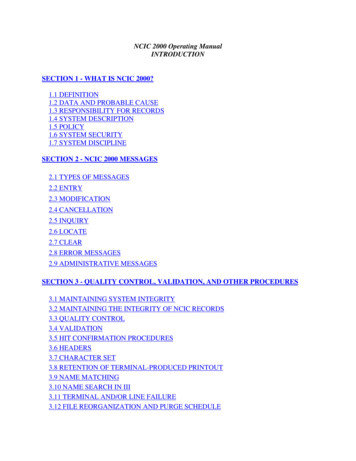
Transcription
NCIC 2000 Operating ManualINTRODUCTIONSECTION 1 - WHAT IS NCIC 2000?1.1 DEFINITION1.2 DATA AND PROBABLE CAUSE1.3 RESPONSIBILITY FOR RECORDS1.4 SYSTEM DESCRIPTION1.5 POLICY1.6 SYSTEM SECURITY1.7 SYSTEM DISCIPLINESECTION 2 - NCIC 2000 MESSAGES2.1 TYPES OF MESSAGES2.2 ENTRY2.3 MODIFICATION2.4 CANCELLATION2.5 INQUIRY2.6 LOCATE2.7 CLEAR2.8 ERROR MESSAGES2.9 ADMINISTRATIVE MESSAGESSECTION 3 - QUALITY CONTROL, VALIDATION, AND OTHER PROCEDURES3.1 MAINTAINING SYSTEM INTEGRITY3.2 MAINTAINING THE INTEGRITY OF NCIC RECORDS3.3 QUALITY CONTROL3.4 VALIDATION3.5 HIT CONFIRMATION PROCEDURES3.6 HEADERS3.7 CHARACTER SET3.8 RETENTION OF TERMINAL-PRODUCED PRINTOUT3.9 NAME MATCHING3.10 NAME SEARCH IN III3.11 TERMINAL AND/OR LINE FAILURE3.12 FILE REORGANIZATION AND PURGE SCHEDULE
3.13 III FILE RESTRICTED SERVICE3.14 NCIC 2000 NUMBERS (NIC NUMBERS)3.15 NEW FEATURESSECTION 4 - USER AGREEMENT SYSTEM RESPONSIBILITIES OF CONTROLTERMINAL AGENCY4.1 INTRODUCTION4.2 CRIMINAL JUSTICE INFORMATION SERVICES USER AGREEMENTSECTION 5 - NCIC 2000 STANDARDS AND SANCTIONS5.1 STANDARDS5.2 STANDARDS FOR INQUIRY RESPONSE TIME - HOT FILES (NON-III) FORSINGLE HIT/NO IMAGE RESPONSES5.3 STANDARDS FOR RESPONSE TIME - III5.4 STANDARDS FOR RECORD ENTRY BY USER AGENCY5.5 STANDARDS FOR SYSTEM AVAILABILITY5.6 STANDARD REGARDING EQUIPMENT AND TECHNOLOGY COMPATIBILITY5.7 STANDARDS FOR SERVICES AVAILABILITY5.8 INTRODUCTION TO NCIC 2000 SANCTIONS5.9 SANCTIONS5.9A COMPUTATION OF A MEAN ERROR RATE AND STANDARD DEVIATIONSECTION 6 - CONTACT INFORMATION6.1 CJIS SYSTEMS AGENCIES (CSAs)6.2 STATE IDENTIFICATION BUREAUS6.3 STATE/TERRITORY SEX OFFENDER REGISTRIES (SORs)6.4 FBI TELEPHONE AND ORI LISTNCIC 2000INTRODUCTIONSECTION 1--WHAT IS NCIC 2000?1.1 DEFINITION1. The National Crime Information Center (NCIC) 2000 is the System replacing the NCICSystem. NCIC 2000 has the same mission and the same basic functionality as NCIC, but alsofeatures new capabilities which are described in this operating manual. Just as NCIC, NCIC 2000
is a nationwide, computerized information system established as a service to all criminal justiceagencies--local, state, and federal. The goal of NCIC 2000 is to help the criminal justicecommunity perform its duties by providing and maintaining a computerized filing system ofaccurate and timely documented criminal justice information. For NCIC 2000 purposes, criminaljustice information is defined as "information collected by criminal justice agencies that isneeded for the performance of their legally authorized, required function. This includes wantedperson information; missing person information; unidentified person information; stolen propertyinformation; criminal history information; information compiled in the course of investigation ofcrimes that are known or believed on reasonable grounds to have occurred, including informationon identifiable individuals; and information on identifiable individuals compiled in an effort toanticipate, prevent, or monitor possible criminal activity." Criminal justice information can beelectronic (paperless) or hard copy (paper). The NCIC 2000 data bank can best be described as acomputerized index of documented criminal justice information concerning crimes and criminalsof nationwide interest and a locator file for missing and unidentified persons.2. The structure and basic procedures of the NCIC System were approved by resolution of thefull membership of the International Association of Chiefs of Police in Philadelphia,Pennsylvania, in October 1966 and apply to the new NCIC 2000 System. General policyconcerning the philosophy, concept, and operational principles of the System is based upon therecommendations of the Criminal Justice Information Services (CJIS) Advisory Policy Board(APB) to the Director of the FBI. The APB is comprised of top administrators from local, state,and federal criminal justice agencies throughout the United States. Through the APB, itsSubcommittee and Working Group input, changes in current applications, the addition of newfiles, and new procedures, e.g., edits, codes, validations, are coordinated with all NCIC andNCIC 2000 participants.3. The NCIC 2000 System stores vast amounts of criminal justice information which can beinstantly retrieved by and/or furnished to any authorized agency.4. The NCIC 2000 System serves criminal justice agencies in the 50 states, the District ofColumbia, Puerto Rico, and Canada. Through established state systems, the NCIC 2000 Systemhas become available for use by all criminal justice agencies. Access to the NCIC 2000 Files byspecific foreign nations is provided through INTERPOL, U.S. National Central Bureau, inWashington, DC.1.2 DATA AND PROBABLE CAUSE1. An NCIC 2000 hit alone is not probable cause to arrest, but indicates that a stolen propertyreport, missing person report, or warrant, etc. may have been filed. A hit is only one elementcomprising sufficient legal grounds for probable cause to arrest.2. Correct NCIC 2000 procedure requires the agency which placed the record in file be contactedby the inquiring agency to confirm that the data are accurate and up-to- date. In somecircumstances, the hit confirmed with the originating agency may be the major or only elementnecessary to detain or make an arrest. For instance, a confirmation of an outstanding warrant onan individual or a hit confirmed on a stolen vehicle or stolen property in a timeframe very close
to the time of an actual theft would likely support an arrest decision. The confirmation of a hit ona person file record, regardless of how long it had been in the System, would be enough cause totake appropriate action. However, when attempting to recover the stolen property record that hadbeen in the System one or two years, the officer would need not only the element of the hit butalso additional facts adding up to probable cause. For instance, a hit on a record two years after avehicle was stolen would in itself be inadequate probable cause for an arrest, since it would bepossible or even probable the vehicle was then in the possession of an innocent purchaser ratherthan the original thief. To make an arrest under these circumstances, the officer would need notonly the element of the hit but also additional facts adding up to probable cause. A hit confirmedwith the originating agency can be adequate grounds to recover stolen property, return a missingperson, arrest a fugitive, or charge a subject with violation of a protection order.3. Files, such as the Gang, Known or Appropriately Suspected Terrorist, Supervised Release,National Sex Offender Registry, Protective Interest, Violent Person, and NICS DeniedTransaction do not require hit confirmation and are designed to provide law enforcement officerswith adequate warning regarding individuals who have had involvement in criminal activities orare known to represent potential danger to the public.1.3 RESPONSIBILITY FOR RECORDS1. NCIC 2000 records must be kept accurate and up-to-date. Agencies that enter records in theNCIC 2000 System are responsible for their accuracy, timeliness, and completeness. To facilitatecompliance with hit confirmation requirements, the originating agency must be available 24hours a day to confirm its record entries. Nonterminal agencies must sign a "Holder of theRecord" agreement with a 24-hour agency delineating the responsibility for hit confirmation.Originating agencies that are not available 24 hours must place instructions for after-hour hitconfirmation, e.g. a 24-hour contact telephone number or an Originating Agency Identifier (ORI)in the Miscellaneous Field.2. Stringent administrative procedures and controls to ensure that accurate data are entered incomputerized criminal justice information systems are important. An officer's evaluation of theinformation contained in a hit response is just as important as keeping the information accurate,timely, and complete. Combining stringent administrative controls with proper evaluation by theofficer receiving the hit can prevent lost court cases, civil liability suits, false arrests, andcriminal charges against the law enforcement officer.3. The FBI, as manager of the NCIC 2000 System, helps maintain the integrity of the Systemthrough:1. Automatic computer edits which reject records with certain common types of errors indata;2. Automatic purging of records after they are on file for a prescribed period of time;3. Quality control checks by FBI personnel; and,4. Distribution of records to be validated. (Details concerning quality control and validationprocedures appear in Section 3 of this Introduction.)
4. The NCIC 2000 System makes centralized crime data immediately available to the criminaljustice community. The success of the System depends upon the extent to which patrol officers,investigators, judges, prosecutors, corrections officers, and other criminal justice agency officialsintelligently use it in day-to-day operations.5. This manual contains instructions designed to guide participants in using the NCIC 2000System. No system can be expected to produce results unless it is properly used. The standardsand procedures set forth should be strictly followed as every exception tends to degrade theSystem and the integrity of the data stored in the System.6. All inquiries regarding the NCIC 2000 System should be addressed to the FBI, CJIS Division,Attention: NCIC 2000, Module E-3, 1000 Custer Hollow Road, Clarksburg, West Virginia26306-0153.1.4 SYSTEM DESCRIPTION1. System participants include local, state, and federal criminal justice agencies throughout theUnited States, Puerto Rico, and Canada.2. Most records are placed directly into the NCIC System by an originating agency (agencyholding warrant, missing person report, or theft report; registration information on sex offender,person on supervised release, etc.), through a control terminal tied into the network. Entries forthe Originating Agency Identifier (ORI) File are made by FBI CJIS staff. Records for fugitiveswanted by foreign countries are entered either by the Royal Canadian Mounted Police or the U.S.National Central Bureau, INTERPOL. Records on immigration violators are entered by theBureau of Immigration and Customs Enforcement. NICS Denied Transaction File records areentered through an interface managed by the FBI based on a National Instant CriminalBackground Check System (NICS) denial. Interstate Identification Index (III) records are placedon file by the FBI based on fingerprint cards submitted by the states. The records entered mustmeet the criteria established for the particular type of record involved. Inquiries must containprescribed identifying data.3. NCIC 2000 provides virtually uninterrupted operation 24 hours a day, 7 days a week.Communication lines and associated costs from the NCIC 2000 computer to the controlterminals are borne by the FBI.4. The FBI NCIC 2000 computer equipment can interface with control terminal equipmentmanufactured by many of the major computer firms. System participants are not required to usethe same make computer equipment as that used by the FBI. The only requirement is thatterminal equipment be able to communicate with either 8 level ASCII Bisynchronous computerto computer (BiSync), Transmission Control Protocol/Internet Protocol (TCP/IP), or IBMSystem Network Architecture (SNA) protocol.1.5 POLICY
1. The CJIS APB recommends general policy to the FBI with respect to the philosophy, concept,and operational principles of the NCIC 2000 System. In its deliberations, the APB placesparticular emphasis on the continued compatibility of NCIC 2000 and state systems; Systemsecurity; and rules, regulations, and procedures to maintain the integrity of NCIC 2000 records.2. The CJIS Advisory Process is composed of two major components, the CJIS APB and theCJIS Working Groups. The APB is responsible for reviewing policy issues and appropriatetechnical and operational issues related to the programs administered by the FBI CJIS Divisionand, thereafter, for making appropriate recommendations to the FBI Director. The 33-memberCJIS APB is composed of the following:1. Twenty criminal justice agency representatives who are selected by the CJIS WorkingGroups and appointed by the FBI Director. (Twelve are state-level agency representatives,and eight are local-level agency representatives.)2. Three individuals who are selected and appointed by the FBI Director and represent thejudicial, the prosecutorial, and the correctional sectors of the criminal justice community,and a fourth member is selected by the FBI Director to represent the national securitysector.3. Eight individuals who represent professional associations including the InternationalAssociation of Chiefs of Police, National Sheriffs' Association, National District Attorneys'Association, American Probation and Parole Association, Major Cities Chiefs' Association,the Major County Sheriffs' Association, American Society of Crime Laboratory Directors,and one executive level representative from a national professional association representingthe courts or court administration.4. The Chairman of the CJIS Federal Working Group.3. A Federal Working Group and four regional Working Groups were established to recommendpolicy and procedures for the programs administered by the FBI CJIS Division. These WorkingGroups are also responsible for the review of operational and technical issues related to theoperation of or policy for these programs. The Working Groups make appropriaterecommendations to the CJIS APB.4. To gain insight and direction into specific program-related issues, the APB receives input fromAd Hoc Subcommittees.1.6 SYSTEM SECURITY1. There is no federal legal or policy prohibition against dissemination of information containedin NCIC 2000 files. If no state/local law or policy prohibition exists, authorized indirectdissemination of NCIC 2000 records is discretionary with the Control Terminal Agency (CTA).Such information may be withheld because of criminal justice priorities, budgetary limitations,or other reasons determined by the CTA to be legitimate.
2. An agency participating in the NCIC 2000 System as a CTA must assume responsibility forand enforce System security with regard to all other agencies which it, in turn, services. Theresponsibilities of NCIC 2000 CTAs are outlined in Section 4 of this Introduction.3. The FBI uses hardware and software controls to help ensure System security. However, finalresponsibility for the maintenance of the security and confidentiality of criminal justiceinformation rests with the individual agencies participating in the NCIC 2000 System. Furtherinformation regarding System security can be obtained from the CJIS Security Policy.4. All state and local agencies participating in the NCIC 2000 System III File are required toadhere to the security guidelines as set forth in the publication, NCIC: Computerized CriminalHistory Program Background, Concept and Policy, and in Subparts A and C of the United StatesDepartment of Justice Regulations governing the dissemination of criminal records and criminalhistory information (Regulations) published in the Federal Register on May 20, 1975, andAugust 7, 1976 (Title 28, Code of Federal Regulations, Part 20). Copies of these documents maybe obtained from the FBI CJIS Division, 1000 Custer Hollow Road, Clarksburg, West Virginia26306. Additional guidelines for state III Files appear in the Regulations published in theFederal Register on March 19, 1976. Additional security guidelines can be found in the CJISSecurity Policy.5. The data stored in the NCIC 2000 System and the III File are documented criminal justiceinformation and must be protected to ensure correct, legal, and efficient dissemination and use. Itis incumbent upon an agency operating an NCIC 2000 terminal to implement the necessaryprocedures to make that terminal secure from any unauthorized use. Any departure from thisresponsibility warrants the removal of the offending terminal from further NCIC 2000participation.6. Information can be obtained from NCIC 2000 and the III File both directly and indirectly.Direct access is terminal access and dissemination within that terminal agency. Indirect access isnonterminal access outside of an agency with direct access.7. The individual receiving a request for criminal justice information must ensure that the personrequesting the information is authorized to receive the data. Dissemination of most file data arediscretionary with the CSA, whereas NCIC Supervised Release, Gang, Known or AppropriatelySuspected Terrorist, Protective Interest, inactive Protection Order, NICS Denied Transactions,Violent Person, and Identity Theft Files; the National Sex Offender Registry; and III data areconfidential and should be treated accordingly. Unauthorized request or receipt of NCICmaterial could result in criminal proceedings brought against the agencies and/or the individualsinvolved.1.7 SYSTEM DISCIPLINE1. To help ensure the proper operation of the NCIC 2000 System, the standards, procedures,formats, and criteria mentioned in this manual must be strictly followed. In this respect,NCIC 2000 CTAs must not only follow the rules set forth but must also ensure that agencies theyare servicing do the same.
2. Complete, accurate, and timely records are essential to ensure System integrity. Users also areencouraged to enter records in a timely manner to afford the maximum protection to the lawenforcement officer by providing up-to-date information. Although the use of NCIC 2000 isvoluntary, delayed entry of records in NCIC 2000 reduces or eliminates the possibility ofapprehending wanted persons, locating missing persons, and recovering stolen property.3. Promptness in modifying, locating, or clearing records in the System will help to keep theSystem free of outdated information.4. NCIC 2000 provides information for decision making by investigators, patrol officers, judges,prosecutors, and corrections officials. The information furnished by NCIC 2000 must beevaluated along with other facts known to the officers, investigators, judges, prosecutors, andcorrections officials.5. When an agency receives a positive response from NCIC 2000 and an individual is beingdetained or a piece of property can be seized, an immediate confirmation with the agency thatoriginated the record in the System is necessary. This confirmation ensures the validity of the hitbefore an arrest or seizure is made. Likewise, the originating agency has the duty to respondpromptly with the necessary confirmation and other pertinent details. (Hit confirmationprocedures can be found in Section 3 of this Introduction.)SECTION 2--NCIC 2000 MESSAGES2.1 TYPES OF MESSAGESThere are six types of messages pertaining to NCIC 2000 that can originate from a user and canbe transmitted to the NCIC 2000 System: entry, modification, cancellation, inquiry, locate, andclear. There are three types of messages that originate from the NCIC 2000 System:acknowledgment messages, inquiry responses, and administrative messages.Throughout this document, messages are specified as being in an NCIC or an NCIC 2000 formatwhen a difference exists. The header preceding a message is the first indicator of the messageformat: 1L01 starts the header of an NCIC message; 1N01 starts the header of an NCIC 2000message. All responses to these transactions are in NCIC 2000 format and the header begins with1L01. A discussion of the various types of NCIC 2000 messages follows.2.2 ENTRYThe purpose of an entry message is to place a new record in file or to append supplementalrecords to those already on file. During an Entry, or Enter-supplemental transaction, new dataentered may cause an Inquiry transaction to occur. These inquiries generate Duplicate-RecordAccept and Duplicate-Record-Reject hits. If the hit responses contain more than 100 total hits,then the following message will be received:"ADDITIONAL HITS AVAILABLE, FILE NOTIFICATION TO FOLLOW"
Entry messages and acknowledgments, including examples, are further explained in the EntrySection of each NCIC 2000 file chapter.2.3 MODIFICATIONThe purpose of a modification message is to add, delete, or change a portion of data which arepart of a record. A record may be modified only by the agency that entered the record as long asthe record is in active status. The only exceptions are modifications to ORI records. All ORIentries are made by FBI CJIS, but modifications may be made by the agency assigned the ORI.During a Modification transaction, modified data entered may cause an Inquiry transaction tooccur. These inquiries generate Duplicate-Record-Accept and Duplicate-Record-Reject hits. Ifthe hit responses contain more than 100 total hits, then the following message will be received:" ADDITIONAL HITS AVAILABLE, FILE NOTIFICATION TO FOLLOW"Modification messages and acknowledgments are further explained in the Modification sectionof each NCIC 2000 file chapter.2.4 CANCELLATIONThe purpose of a cancellation message is to remove an entire record or supplemental record(s)from any file. Additionally, a cancellation message is used to clear NCIC add-on vehicle andboat records. When a record is canceled, all supplemental records appended to it are alsoautomatically canceled. A record may be canceled only by the agency that entered the record.However, the FBI Data Integrity Staff may cancel a record when a serious error is detected. (The .E. administrative message can be found in Section 2 of this Introduction.) A record should becanceled when it is determined to be invalid; for example, the warrant which was the basis forthe record has been dismissed, or the record is the result of a fictitious theft report.Cancellation messages and acknowledgments are further explained in the Cancellation section ofeach NCIC 2000 file chapter.2.5 INQUIRYFour types of inquiries may be made into the NCIC 2000 System:1. On-line InquiriesThese are queries into NCIC 2000 databases for which the user expects immediate reply. Thereare two types of on-line inquiry messages:1. Z inquiry (ZW, ZV, ZG, etc.) -- Initially intended to be used for administrativepurposes and for training, demonstrations, and display of records for validationand/or review.
2. Q inquiry (QW, QV, QG, etc.) -- Intended to be made for all other inquirytransactions.3. Both Z and Q inquiries are now processed exactly the same way.2. On-line Requests for Off-line SearchesThese queries include special request inquiry, also known as Global Inquiry or SPRQ, which canbe initiated by a CTA to obtain information that cannot be retrieved through a normal inquiry.SPRQ transactions can be made against:1. Active Records2. Retired Records3. Message Logs3. On-line Requests for Statistical DataThese requests include Usage Analysis, Error Trend Analysis, and Benefits and Effectiveness.The requests are submitted on-line and the results are obtained by file transfer. These inquiriesare limited to CTAs only.4. On-line Requests for Batched InquiriesThese requests (batch inquiry is grouping several on-line inquiries into one) may be made by allusers, allowing them to group several inquiries on the same database. The purpose of an on-lineor a batch on-line inquiry is to search an NCIC 2000 file(s) for a record possibly identifiable withinformation available to the inquiring agency. The MKE for batch inquiry is a three-letter codeconsisting of the regular inquiry MKE and ending with a B for BATCH. For example: QWB,batch wanted person inquiry; QAB, batch article inquiry.5. Negative Response to an On-line Inquiry1. A negative response is transmitted when no record match is found inNCIC 2000. A negative response to a person file inquiry (ForeignFugitive, Missing Person, Wanted Person, etc.) contains a header, the ORIof the inquiring agency followed by NO NCIC WANT witheach searchable numeric identifier inquired upon. This is a general personinquiry and searches all person files.2. A negative response for a specific person file, such as Protection Order,National Sex Offender Registry, Identity Theft, and NICS DeniedTransaction contains a header and the ORI of the inquiring agencyfollowed by NO NCIC RECORD; NO NCIC PROTECTION ORDERFILE RECORD; NO NCIC SEX OFFENDER FILE RECORD; NO NCIC
IDENTITY THEFT FILE RECORD; or NO NCIC NICS DENIEDTRANSACTION FILE RECORD followed by the searchable identifiersincluded in the inquiry.3. A negative response to a Gang Reference, Gang Member, and Known orAppropriately Suspected Terrorist, or property file inquiry contains aheader, the ORI of the inquiring agency followed by NO RECORD witheach searchable identifier or set of searchable identifiers inquired upon. Anegative response to an NCIC on-line inquiry, however, should not berelied upon as an indication that the person or property inquired upon isnot wanted, missing, or stolen, or that no criminal history record exists.As with a positive response, a negative response should not be used as thesole basis for decision making by the receiving officer.6. Positive Response to an On-line InquiryA positive response is transmitted when a record(s) is found in NCIC 2000. Apositive response contains a header, the ORI of the inquiring agency followed byan alert(s) (if applicable), the record in file, and an IMMED CONFIRM message:1. IMMED CONFIRM MISSING PERSON STATUS WITH ORIThis message appears after each missing person record in the response. Thephrase is a reminder to the inquiring agency that it must immediately contact theagency(s) that entered the record(s) to assure that there has been no change in themissing person's status and to verify the subject's identity.2. IMMED CONFIRM WARRANT AND EXTRADITION WITH ORIThis message appears after each wanted person record in the response. The phraseis a reminder to the inquiring agency that it must immediately check with theagency(s) that entered the wanted person record(s) to verify the identity of theindividual, determine if there has been any change in the status of the warrant,and, if applicable, obtain extradition details. If the record indicates no extradition,confirmation may be required intrastate; however, no action should be taken todetain the person based on an interstate hit.3. IMMED CONFIRM RECORD WITH ORI AND FOLLOW PROCEDURESIN INTERSTATE COMPACT ON JUVENILESThis message appears after each juvenile offender (MKE/EWJ) record in theresponse. It reminds the inquiring agency that it must immediately check with theentering agency to determine if there has been a change in the status of the record.In addition, it also advises the inquiring agency to follow the guidelines as writtenin the Interstate Compact on Juveniles.
4. IMMED CONFIRM RECORD WITH ORI AND FOLLOW PROCEDURESIN INTERSTATE COMPACT ON JUVENILES.CAUTION: THIS JUVENILE IS EMANCIPATED.PLEASE CHECK YOUR STATE LAWS REGARDING APPROPRIATEACTIONThis message follows a juvenile offender (MKE/EWJ) record when the juvenilehas been emancipated. It reminds the inquiring agency to check with the enteringagency to determine if there has been a change in the record's status.5. IMMED CONFIRM RECORD WITH ORIThis message follows each property file record in the response. The phrase is areminder to the inquiring agency that it must immediately contact the agency(s)that entered the record(s) to assure that no change in status has taken place.6. WARNING - DO NOT ARREST BASED ON THIS INFORMATIONThis message precedes a Canadian warrant record.REPEAT - WANTED IN CANADA - DO NOT ARREST BASED ON THISINFORMATION - IMMEDIATELY CONTACT RCMP, OTTAWA, CANADATEL NO. (613)998-6200. IF THE SUBJECT IS NOT U.S. CITIZEN, CONTACTNEAREST OFFICE OF U.S. IMMIGRATION AND NATURALIZATIONSERVICEThis message appears after each Canadian warrant record in the response. Thephrase is a reminder to the inquiring agency that the fugitive is wanted on aCanadian warrant, and no arrest can be executed in the United States based on theCanadian warrant.RECORD NIC/R123456789 IS A CANADIAN VEHICLE INDEX RECORDCONFIRM RECORD WITH ORIorRECORD NIC/R123456789 IS A CANADIAN BOAT INDEX RECORDCONFIRM RECORD WITH ORIorRECORD NIC/R123456789 IS A CANADIAN LICENSE PLATE INDEXRECORD CONFIRM RECORD WITH ORIorRECORD NIC/R123456789 IS A CANADIAN VEHICLE/BOAT PARTINDEX RECORDCONFIRM RECORD WITH ORIOne of these messages appears before each positive response from the CanadianVehicle Index.
REPEAT - THIS IS A CANADIAN RECORD - CONFIRM WITH THEORIGINATING AGENCY IN CANADAThis message follows each Canadian Vehicle Index record response.8. WARNING-DO NOT ARREST OR DETAIN BASED SOLELY UPON THISINFORMATIONThis message precedes a Protective Interest File record response when the ORI isDCSS80201.***** REPEAT - DO NOT ARREST OR DETAIN BASED SOLELY UPON THISINFORMATION***CALL COLLECT U.S. SECRET SERVICE HEADQUARTERS, TEL NO. 202406-5000WHICH HAS BEEN NOTIFIED OF THIS TRANSACTION. THIS RECORD IS FORCRIMINALJUSTICE AGENCIES FOR CRIMINAL JUSTICE PURPOSES.***DO NOT DISSEMINATE OR USE FOR LICENSING AND EMPLOYMENTPURPOSES*****This message appears after each Protective Interest File record in the responsewhen the ORI is DCSS802Q1. The phrase is a reminder to the inquiring agencythat the Secret Service has interest in the subject of the record, and no arrestshould be made based on the information received.WARNING - DO NOT ARREST OR DETAIN BASED SOLELY UPON THIS INFORMATION.OBTAINIDENTIFYING INFORMATION. SUBJECT IDENTIFIED AS A CREDIBLE THREATENER ANDPOTENTIAL DANGER TO U.S. MARSHALS SERVICE PROTECTEE. IMMEDIATELY CONTACTUSMS COMMUNICATIONS CENTER AT 202-307-9100 FOR FURTHER INFORMATION.This message precedes a Protective Interest File record response when the ORI is USM .***** CONTACT USMS COMMUNICATIONS CENTER AT 202-307-9100 WHICH HAS BEENNOTIFIED OF THIS TRANSACTION. THIS RECORD IS FOR CRIMINAL JUSTICEAGENCIESFOR CRIMINAL JUSTICE PURPOSES.***DO NOT DISSEMINATE OR USE FOR LICENSING AND EMPLOYMENT PURPOSES*****This message appears after each Protective Interest
full membership of the International Association of Chiefs of Police in Philadelphia, Pennsylvania, in October 1966 and apply to the new NCIC 2000 System. General policy concerning the philosophy, concept, and operational principles of the System is based upon the
